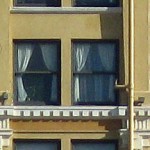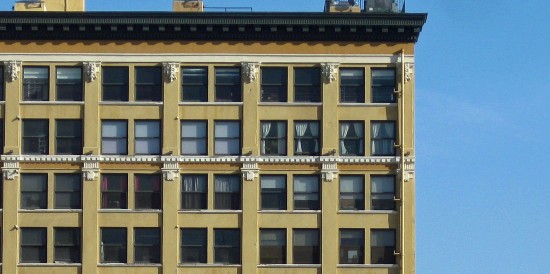Above is a shot taken yesterday from Broadway of the landmark Higgins Building on the southwest corner of Second and Main, looking east at its backside bathed beautifully Hopper-esque in the afternoon light. Susan and I had a wonderful excursion that started with lunch at Cole’s, and then a stroll up to this building so that I could express my requisite awe in the wake of my discovery that one of my heroes, Clarence Darrow, kept an office here while representing the infamous McNamara brothers who bombed the original Los Angeles Times building (at First and Broadway) in 1910 and killed 20 people.
Afterward we visited the Bradbury Building, Grand Central Market, and rode Angel’s Flight to the top of Bunker Hill, which we descended via Hope Street to go to the Central Library and pick up the new biography of Darrow by John Farrell I had on hold, Clarence Darrow: Attorney for the Damned. From the library we worked our way back to the Drkrm Gallery on Spring Street south of Seventh to check out an exhibit of Ansel Adams’ photographs of Los Angeles in the 1930s. Lastly we explored the incredible space of The Last Bookstore at Spring and Fourth Fifth.
But back to Darrow. I’ve been an unabashed idolizer of his (and subsequent skeptic of religion) since a 13-year-old when I checked out a copy of the play “Inherit the Wind” by Jerome Lawrence and Robert E. Lee from the LeConte Junior High School library, based on the 1925 Scopes trial in Tennessee, in which he represented the defendant who challenged that state’s anti-evolution law. The first monologue I ever did as an acting class student at Beverly Hills High School was one of Drummond’s (Darrow) from that play:
Yes there is something holy to me! The power of the individual human mind. In a child’s power to master the multiplication table there is more sanctity than in all your shouted “Amens!,” “Holy, Holies!” and “Hosannahs!” An idea is a greater monument than a cathedral. And the advance of man’s knowledge is more of a miracle than any sticks turned to snakes, or the parting of waters. But are we now to halt the march of progress because Mr. Brady frightens us with a fable? (to the jury) Gentlemen, progress has never been a bargain. You’ve got to pay fo rit. Sometimes I think there’s a man behind a counter who says, “All right, you can have a telephone; but you’ll have to give up rivacy, the charm of distance. Madam, you may vote; but at a price; you lose the right to retreat behind a powderpuff or a petticoat. Mister, you may conquer the air; but the birds will lose their wonder, and the clouds will smell of gasoline!” Darwin moved us forward to a hilltop, where we could look back and see the way from which we came. But for this view, this insight, this knowledge, we must abandon our faith in the pleasant poetry of Genesis.
Anyway, through a recent issue of Smithsonian magazine I learned via an excerpt from Farrell’s book that he had an office in the Higgins during the McNamara trial and afterwards during what was the darkest time of his life and career as a lawyer, when he was tried twice on charges of bribing McNamara jurors. The first ended in his acquittal, the second with a hung jury, and a subsequent deal with the district attorney was struck in which he agreed there would be no retrial if Darrow promised never to practice law again in California. Darrow then went on to some of his greatest legal battles — including the Scopes trial.
 As I looked over the buildings features and details and stood in its foyer where Darrow had undoubtedly stood more than 100 years ago, I figured it might be lost to history where his office had actually been within, but that of course didn’t stop me from googling it and finding via the LA Times that it was on the southwest corner of the ninth floor, the windows of which — second floor from the top — are visible in the picture.
As I looked over the buildings features and details and stood in its foyer where Darrow had undoubtedly stood more than 100 years ago, I figured it might be lost to history where his office had actually been within, but that of course didn’t stop me from googling it and finding via the LA Times that it was on the southwest corner of the ninth floor, the windows of which — second floor from the top — are visible in the picture.

 Follow
Follow